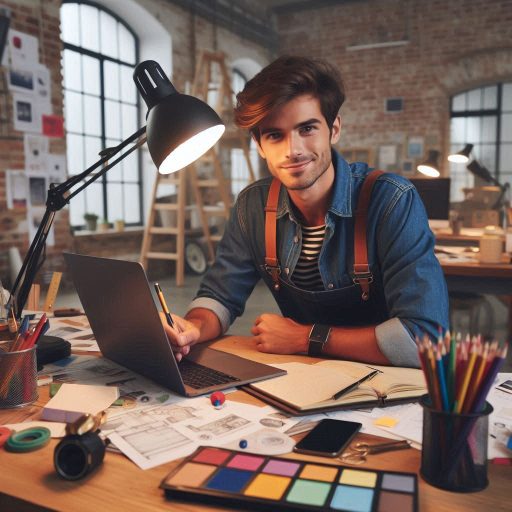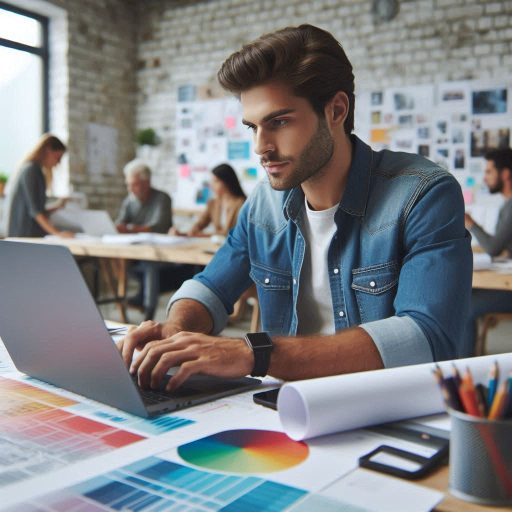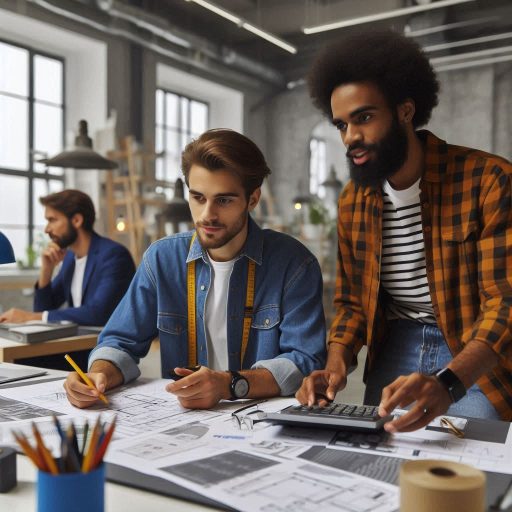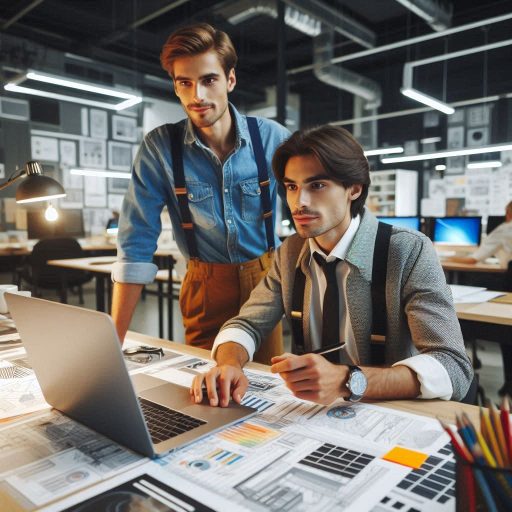Introduction
Exhibition design is a specialized field that focuses on creating visually compelling and immersive environments for showcasing products, artwork, ideas, or historical artifacts.
It involves blending creativity, technical skills, and strategic planning to transform physical spaces into engaging experiences that tell a story and captivate audiences.
Whether in museums, art galleries, trade shows, or cultural institutions, exhibition design plays a key role in shaping how visitors interact with and understand the content on display.
Exhibition designers are essential in bringing these spaces to life.
They craft layouts, choose materials, and utilize lighting and technology to enhance the presentation and ensure that the subject matter is both informative and visually appealing.
Their work elevates the significance of the objects or products on display, helping viewers connect with the message or story being conveyed.
Whether it’s an art exhibition that draws viewers into the emotions of a piece, or a trade show that highlights the latest products, exhibition designers have a profound impact on the success of these events.
The purpose of this blog post is to delve into the vital role of exhibition designers, exploring the skills and creativity they bring to their work.
We will look at how they collaborate with various professionals to create cohesive and impactful designs, and why their contributions are essential to the success of any exhibit.
Additionally, the post will provide insights for readers interested in pursuing a career in exhibition design, offering a deeper understanding of the profession and its numerous opportunities.
Definition and role of an exhibition designer
Explanation of What an Exhibition Designer Does
An exhibition designer is responsible for designing engaging and immersive displays for museums, galleries, trade shows, and other events.
Their role is to create layouts that not only display objects but also tell a story, guiding visitors through the space in a logical and impactful way.
They combine art, architecture, and technology to produce unique environments that align with the theme of the exhibition, whether educational, artistic, or commercial.
Responsibilities in Planning and Creating Exhibits
Exhibition designers handle a variety of responsibilities when planning and creating exhibits.
The process starts with thorough research on the subject matter to ensure a deep understanding of the exhibit’s theme.
Designers sketch out concepts, create models, and develop floor plans that dictate the flow of the exhibit.
They carefully consider the placement of objects, lighting, and signage to enhance the visitor experience.
Additionally, exhibition designers must factor in practical considerations such as budget, accessibility, and safety regulations.
This means they are responsible for selecting materials that are both visually appealing and functional.
They also plan the use of technology and multimedia elements to make the exhibit more interactive and engaging for visitors.
Collaborating with Clients and Other Professionals in the Design Process
Collaboration is a key aspect of an exhibition designer’s role.
Designers work closely with clients to understand their vision, goals, and budget constraints.
Regular communication with the client ensures that the design remains aligned with their expectations throughout the process.
The designer must also be able to explain design choices and offer solutions to any concerns or challenges that arise.
Exhibition designers also collaborate with other professionals, including graphic designers, architects, lighting experts, and contractors.
Each of these specialists contributes to different aspects of the project.
The designer’s role is to coordinate their efforts to ensure that every element of the exhibit comes together harmoniously.
This collaboration ensures that the final exhibit not only meets aesthetic and functional requirements but also provides an engaging experience for visitors.
an exhibition designer plays a crucial role in creating visually compelling and well-organized exhibit spaces.
They manage the design process from concept to installation, ensuring that exhibits are both functional and engaging.
Through collaboration with clients and other professionals, exhibition designers bring their creative visions to life, making them essential contributors to successful exhibitions.
Read: Character Design Trends: What’s Hot in 2024?
Skills Required for Exhibition Design
Exhibition design requires a unique combination of technical knowledge, creativity, and organizational skills.
Designers must possess a strong foundation in various areas to ensure they create exhibits that are visually striking, functional, and completed within constraints.
Below are the key skills necessary for a successful exhibition designer:
Creativity and Artistic Abilities
Creativity is at the heart of exhibition design.
Designers must think outside the box to create immersive, innovative environments that captivate and engage visitors.
The ability to transform ordinary spaces into extraordinary experiences through imaginative design is crucial.
This creativity applies to both the overall concept of the exhibit and the specific details that bring it to life, such as lighting, color schemes, and interactive elements.
Attention to Detail
An exhibition designer must have a sharp eye for detail.
Every element, from object placement to the design of signage and pathways, requires meticulous planning.
Attention to detail ensures that the exhibit flows seamlessly and that all elements contribute to a cohesive, well-thought-out presentation.
Overlooking small details can disrupt the visitor’s experience or compromise the exhibit’s functionality.
Knowledge of Materials and Construction Techniques
Exhibition designers must have a strong understanding of materials and construction techniques to ensure their designs are executed effectively and realistically.
Knowledge of different types of materials, such as wood, metal, glass, and fabrics, allows them to make informed decisions on what best suits the exhibit’s theme and requirements.
They must also understand how these materials behave in different settings and how they can be safely and effectively constructed within the space.
Ability to Work Within a Budget and Timeline
Exhibition designers must balance creativity with practical constraints, such as budgets and deadlines.
They are responsible for creating designs that are not only engaging but also feasible within the client’s financial limits.
This requires careful planning and resource management.
The designer must allocate funds for materials, labor, and other elements while ensuring that the project remains within budget.
Additionally, they must work efficiently to meet the set timeline for the exhibition’s opening, coordinating with other professionals to avoid delays.
In summary, exhibition designers must combine creativity, precision, technical knowledge, and project management skills to create successful exhibits.
Each of these abilities plays a crucial role in ensuring that the final exhibit meets the aesthetic, functional, and financial expectations of the client and provides a memorable experience for visitors.
Read: Best Tools and Software for Character Designers
Process of Exhibition Design
The exhibition design process involves several key stages that transform an idea into a fully realized exhibit.
This process is both creative and methodical, ensuring that the final design aligns with the client’s vision and engages visitors effectively.
Below are the primary steps in the exhibition design process:
Researching the Exhibition Theme or Concept
The first step in the exhibition design process is researching the theme or concept of the exhibition.
Designers gather information about the subject matter to understand its purpose, relevance, and the message it aims to convey.
This research includes studying the content, audience demographics, and the specific goals of the exhibit.
It helps designers create a plan that aligns with the subject matter and resonates with visitors, ensuring that the exhibit communicates its story effectively.
Developing a Design Proposal
After completing the research, the designer develops a comprehensive design proposal.
This proposal outlines the overall vision, including key elements like layout, materials, and design features.
It provides a roadmap for how the exhibit will be structured and how visitors will experience it.
The proposal also includes timelines, budget estimates, and a breakdown of any technical requirements.
This step is critical because it gives clients a clear understanding of what to expect and allows them to provide feedback before moving forward with the project.
Creating Sketches and Mock-ups
Once the design proposal is approved, the next step is to create detailed sketches and mock-ups of the exhibit.
Designers use these visuals to present the spatial layout, object placement, and interactive elements.
These sketches help clients and other team members visualize the final design and make any necessary adjustments early in the process.
Mock-ups may also include 3D models or digital renderings, offering a more immersive preview of the exhibit’s look and feel.
This step ensures that the design is fully refined before the construction phase begins.
Building and Installing the Exhibit
The final step in the exhibition design process is building and installing the exhibit.
This phase involves coordinating with contractors, fabricators, and other professionals to bring the design to life.
Designers oversee the construction process, ensuring that every detail of the plan is executed precisely and efficiently.
They oversee the installation of display cases, lighting, and signage.
They manage logistics, including timing and material deliveries, to ensure the exhibit is installed on schedule.
After building the exhibit, the designer fine-tunes details by adjusting lighting, placement, and interactive elements to improve the visitor experience.
The process of exhibition design is a structured journey that moves from research and concept development to the final installation.
Each step is crucial in ensuring that the exhibit is both functional and engaging for visitors.
By following this process, designers create exhibits that tell compelling stories and offer immersive, memorable experiences.
Read: Ceramic Art: From Hobby to Professional Career

Collaboration and Communication
Collaboration and effective communication are essential components of the exhibition design process.
Exhibition designers work with a variety of stakeholders to ensure the final product aligns with the client’s vision and meets practical requirements.
Here’s how collaboration and communication play a vital role in exhibition design:
Working with Clients to Understand Their Vision
Exhibition designers must work closely with clients to fully understand their vision for the project.
This collaboration involves in-depth discussions about the goals, themes, and desired visitor experience.
Designers ask questions to clarify the client’s expectations and provide guidance on what’s feasible within the budget and timeline.
A successful design begins with clear communication to ensure both the client and designer are aligned on the objectives.
Coordinating with Other Design Team Members
Exhibition design is rarely a solo endeavor; it involves a team of professionals, including graphic designers, architects, lighting specialists, and contractors.
The exhibition designer acts as the central coordinator, ensuring all elements come together seamlessly.
They are responsible for making sure that the creative vision is maintained while also addressing technical and logistical challenges.
Regular communication with team members ensures the project stays on track and all aspects of the design are executed as planned.
Transform Your Career Today
Unlock a personalized career strategy that drives real results. Get tailored advice and a roadmap designed just for you.
Start NowCommunicating Effectively to Ensure Everyone Is on the Same Page
Effective communication is crucial to avoid misunderstandings and ensure the project runs smoothly.
This includes updating clients on progress, seeking their feedback, and making necessary adjustments.
It also involves keeping the design team informed of any changes or challenges that may arise during the project.
By maintaining open lines of communication, exhibition designers ensure that everyone involved stays aligned with the project’s goals and timelines.
Collaboration and communication are the foundation of a successful exhibition design project.
From understanding the client’s vision to coordinating with team members, effective interaction ensures that the final exhibit meets expectations and delivers a memorable experience.
Read: How to Create Memorable Characters: Pro Tips
Use of Technology in Exhibition Design
Technology plays a pivotal role in modern exhibition design, enhancing both the planning process and the visitor experience.
By integrating advanced tools and techniques, exhibition designers can create more engaging and immersive exhibits.
Below are the key ways technology is utilized in exhibition design:
Utilizing Computer-Aided Design (CAD) Software for Mock-ups
Computer-aided design (CAD) software is an essential tool for exhibition designers, allowing them to create detailed digital mock-ups and floor plans.
These 3D visualizations help designers and clients better understand the layout, object placement, and overall structure of the exhibit.
CAD software enables designers to experiment with different design elements, such as lighting, colors, and materials, before any physical work begins.
This technology also ensures precision in measurements and helps streamline the construction phase, reducing errors and saving time.
Incorporating Virtual Reality (VR) or Augmented Reality (AR) Technology in Exhibit Planning
Virtual reality (VR) and augmented reality (AR) technologies are increasingly being used in the exhibit planning process.
VR allows designers and clients to virtually “walk through” the exhibit before it’s built, providing a realistic sense of the space, flow, and visitor experience.
Designers can test different configurations and make adjustments in real time, minimizing costly changes during installation.
AR technology, on the other hand, overlays digital elements onto the physical space, helping designers visualize how specific components will look when integrated into the exhibit.
These tools offer a more immersive design experience and improve communication between the designer and client.
Enhancing Visitor Experience Through Interactive Displays
Incorporating technology into the final exhibit is key to enhancing the visitor experience.
Interactive displays, powered by touchscreens, sensors, or mobile applications, allow visitors to engage more deeply with the exhibit’s content.
Technology can bring static exhibits to life, offering videos, sound effects, or games that offer additional layers of information and engagement.
For example, an exhibit on ancient history might feature an interactive map that allows visitors to explore different civilizations in detail.
These interactive elements not only make the exhibit more engaging but also cater to diverse learning styles.
Technology is integral to both the design and execution of modern exhibits.
CAD software aids in the precision and planning stages, while VR and AR technologies offer immersive ways to visualize the final design.
Finally, incorporating interactive displays and digital elements enhances the visitor experience, making exhibits more dynamic and memorable.
By leveraging these tools, exhibition designers can push the boundaries of creativity and create exhibits that leave a lasting impression on audiences.
Trends in Exhibition Design
Exhibition design is constantly evolving, driven by new technologies, environmental concerns, and the need to create engaging experiences for visitors.
Designers are increasingly adopting innovative approaches to captivate audiences and convey information in compelling ways.
Here are some key trends shaping modern exhibition design:
Incorporating Sustainable Materials and Practices
Sustainability has become a significant trend in exhibition design as businesses and institutions aim to reduce their environmental impact.
Designers are increasingly turning to eco-friendly materials like recycled wood, bamboo, and biodegradable plastics to construct exhibits.
Additionally, sustainable practices such as energy-efficient lighting and reusable components are being prioritized.
These efforts not only align with the growing focus on environmental responsibility but also appeal to an audience that values green initiatives.
By designing exhibits with sustainability in mind, designers help reduce waste and promote awareness of environmental issues.
Creating Immersive Experiences for Visitors
One of the most prominent trends in exhibition design is the move toward creating immersive, multi-sensory experiences for visitors.
Instead of simply viewing static displays, visitors now expect to interact with the content and feel like they are part of the story.
Designers use a combination of visual, auditory, and sometimes tactile elements to fully engage the audience.
For example, museums may use soundscapes, projection mapping, or even smells to transport visitors to a different time or place.
These immersive experiences leave a lasting impression, encouraging visitors to explore exhibits in a deeper, more meaningful way.
Using Digital Technology to Enhance Storytelling
Digital technology has revolutionized how stories are told within exhibits.
From augmented reality (AR) and virtual reality (VR) to interactive screens and mobile apps, technology enables designers to create more dynamic and layered narratives.
Digital tools help enhance storytelling by providing visitors with additional context and interactive elements.
For example, a historical exhibit might use AR to allow visitors to view 3D reconstructions of ancient artifacts on their smartphones.
This technology adds depth to the exhibit, making the content more engaging and accessible.
By integrating digital solutions, exhibition designers create more personalized and interactive experiences.
Modern exhibition design is heavily influenced by sustainability, immersive environments, and digital innovation.
Designers are focusing on creating engaging experiences that not only educate but also resonate with visitors on a deeper level.
Through the use of sustainable materials, immersive design techniques, and cutting-edge digital technology, the field of exhibition design continues to evolve, providing fresh and innovative ways to tell stories and capture the audience’s imagination.
These trends will likely continue to shape the future of exhibitions, pushing the boundaries of creativity and environmental responsibility.
Conclusion
Exhibition designers are integral to creating captivating, informative, and visually stunning displays that enhance visitor experiences.
Their role involves blending creativity with technical skills to design exhibits that communicate ideas, tell stories, and engage audiences in unique and meaningful ways.
They consider the layout, materials, lighting, and overall aesthetic to create spaces that guide visitors through a narrative, making the content of an exhibit more memorable and impactful.
Whether working in museums, galleries, trade shows, or cultural institutions, exhibition designers help shape how we experience history, art, technology, and products.
A career in exhibition design offers a dynamic, fulfilling path for those passionate about both design and storytelling.
It provides opportunities to work in diverse environments, collaborate with professionals across various fields, and see the tangible results of your creativity.
If you love transforming spaces and crafting immersive experiences, consider a career in this field. It could be a perfect fit for you.
Ultimately, well-designed exhibits not only educate but also inspire and leave a lasting impression, shaping how audiences connect with the world around them.
[E-Books for Sale]
The Big Book of 500 High-Paying Jobs in America: Unlock Your Earning Potential
$19.99 • 500 High-Paying Jobs • 330 pages
Explore 500 high-paying jobs in America and learn how to boost your career, earn more, and achieve success!
See All 500 High-Paying Jobs of this E-Book
1001 Professions Without a Degree: High-Paying American Jobs You Can Start Now
$19.99 • 1001 Professions Without a Degree • 174 pages
Discover 1001 high-paying jobs without a degree! Unlock career tips, skills, and success strategies for just $19.99!




